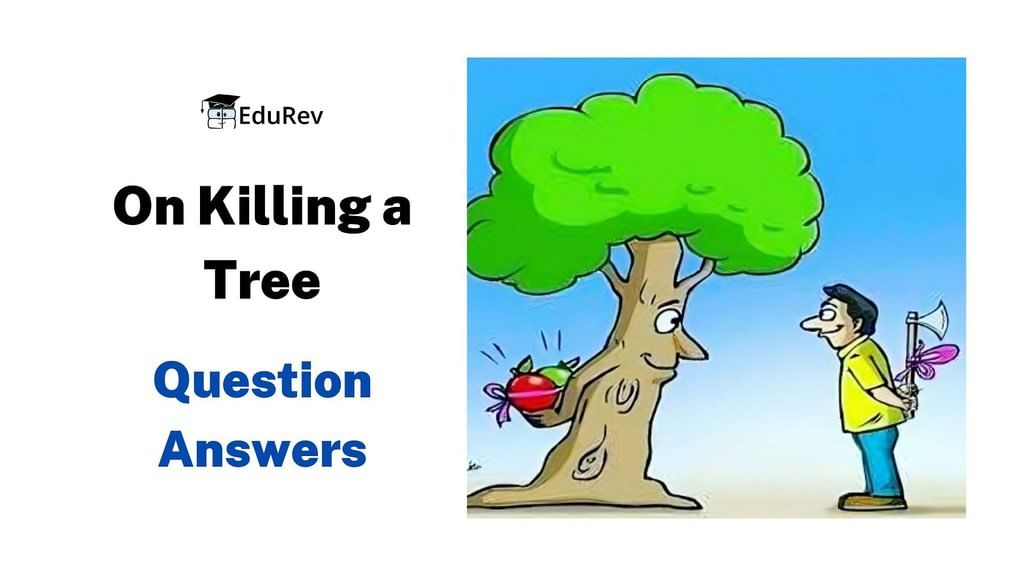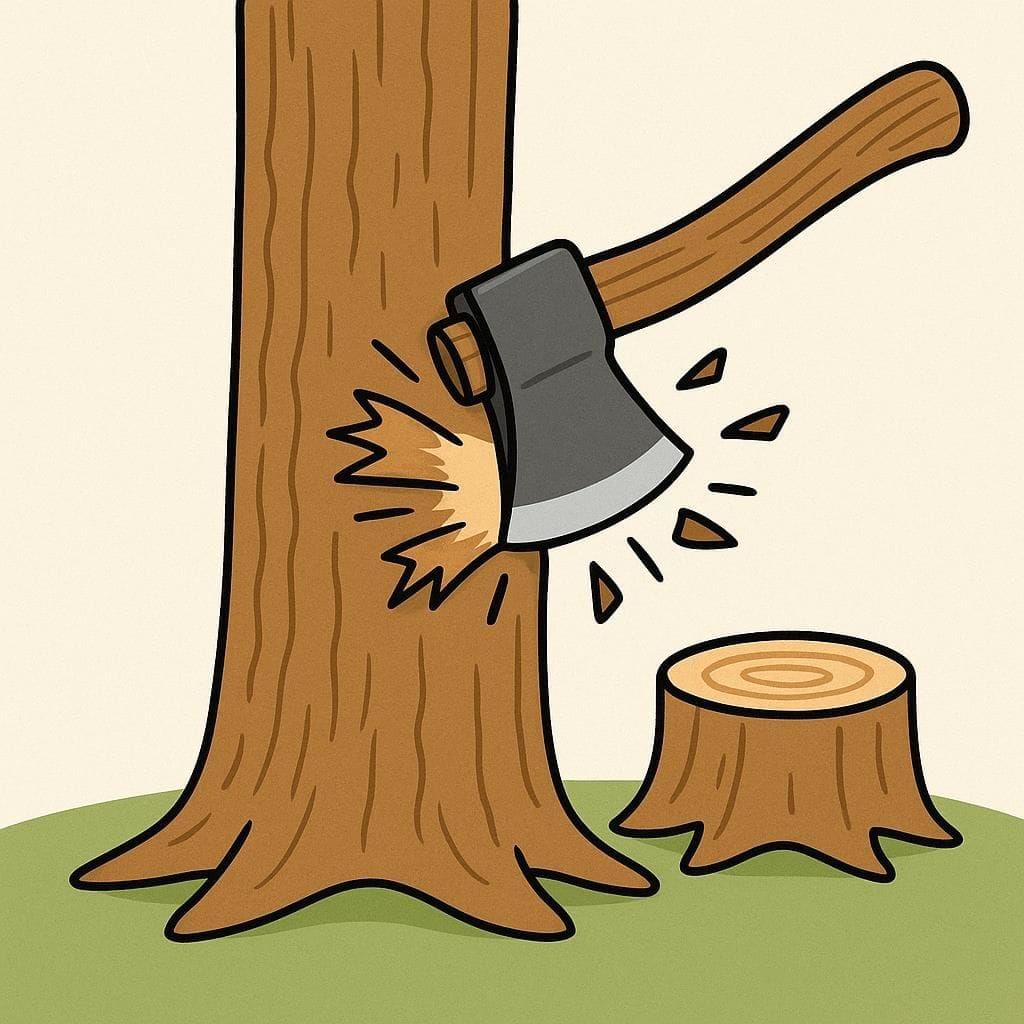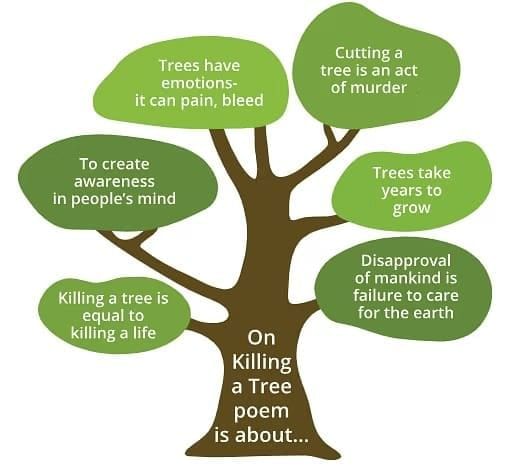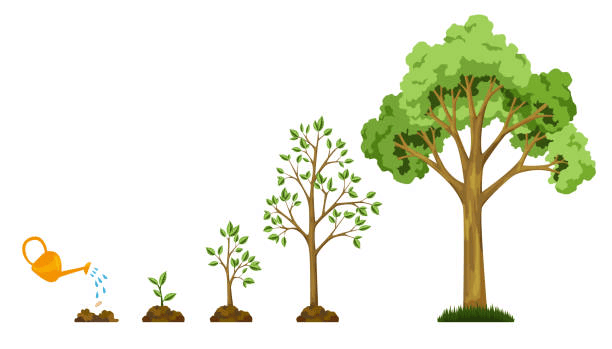Class 9 Beehive Poem Chapter 7 Important Question Answers - On Killing a Tree

Very Short Answer Type Questions
Q1. In the poem ‘On Killing A Tree’ what is the tree a symbol of?
Ans: In this poem, the tree is a symbol of deep-rooted evil.
Q2. How does a tree grow up?
Ans: A tree grows up by getting food and other nutrients from the earth.
Q3. Can we kill a tree with a simple jab of the knife?
Ans: No, we can’t kill a tree with a simple jab of the knife.
Q4. How should we kill a tree?
Ans: By hacking and chopping its trunk, but even this alone isn’t enough to kill it permanently.
 Q5. What should we do to kill a tree permanently?
Q5. What should we do to kill a tree permanently?
Ans: To kill a tree permanently we should take out its root from the earth.
Q6. Where does the strength of a tree lie?
Ans: The strength of a tree lies in its roots.
Q7. What should be done to the roots or a tree?
Ans: The roots of a tree should be snapped and taken out of the earth.
Q8. What finally kills the tree?
Ans: Scorching and choking kill the tree finally.
Q9. What does it mean ‘the strength of the tree is exposed’?
Ans: It means the roots of the tree are taken out of the earth.
Q10. It is easy to kill a tree?
Ans: No, it is not easy to kill a tree.

Short Answer Questions
Q1. Can a “simple jab of the knife” kill a tree? Why not?
Ans: A tree cannot be killed by a simple jab of a knife. Such an action may cause an injury and make the tree's sap flow out like blood. The survival of a tree relies on its roots, which provide essential nourishment and stability.
Q2. How has the tree grown to its full size? List words suggestive of its life and activity.
Ans: The tree has grown slowly by drawing nutrients from the soil. Words from the poem that suggest its vitality are:
- “slowly consuming the earth”
- “rising out of it”
- “feeding”
- “absorbing”
- “sprouting leaves”
Q3. In the phrase ‘consuming the earth’, who consumes the earth and how?
Ans: The tree consumes the earth by drawing nourishment from the soil through its roots. Its diet is found deep within the earth, where the roots absorb essential nutrients to sustain the tree.
Q4. What is meant by ‘years of sunlight, air, and water’?
Ans: 'Years of sunlight, air, and water' describe the long time it takes for a tree to grow fully. During this period, the tree absorbs energy from these elements to support its growth.
Q5. Why has the tree’s ‘hide’ been called leprous?
Ans: The tree's bark is described as uneven in both texture and colour, resembling the skin of a person with leprosy. Just as leprosy affects the skin, causing it to lose its colour and smoothness, the tree's bark appears discoloured and rough. This creates a metaphorical link between the tree's bark and the condition of diseased skin.
 Leprosy Disease
Leprosy Disease
Q6. What is the role of hacking and chopping in killing a tree?
Ans: Hacking and chopping a tree cause significant damage to its body, leading to great pain. These actions remove the bark, resulting in sap oozing out, which resembles bleeding. Despite this, such injuries alone are insufficient to kill the tree, as it can heal and continue to grow.
Q7. What is the meaning of ‘bleeding bark’? What makes it bleed?
Ans: The term ‘bleeding bark’ refers to the sap that seeps from a tree's trunk when it is injured, such as by a knife or axe. The word ‘bleeding’ is used metaphorically to liken the sap to blood from a human wound, symbolising the tree's pain.
Q8. What will rise from ‘close to the ground’? Why?
Ans: Curled green twigs and miniature boughs will emerge from the stump of a tree that is close to the ground. This happens because the tree can rejuvenate and revive itself as long as its roots remain intact.
Q9. What will happen if the miniature boughs are left ‘unchecked’?
Ans: If left unchecked, the new, green branches that sprout from a tree's stump will grow freely. This means they will expand and return to their original size, regaining their strength and vitality.
Q10. “No, The root is to be pulled out.” Why has the poet started this stanza with “No”? Or The poet says “No” at the beginning of the third stanza. What does he mean by this?
Ans: The poet begins with No to stress that simply hacking or chopping a tree is not enough to kill it. These actions may harm the tree, causing it to bleed and suffer, but true destruction requires more determination and effort. To effectively kill a tree, one must pull out the root, which is deeply anchored in the earth.
Q11. What is the meaning of “anchoring earth” and “earth cave”?
Ans: Anchoring earth refers to the soil that provides a strong grip for a tree, preventing it from falling. Just as a ship remains securely in place when anchored in water, a tree stands firm and stable with the support of the earth. Earth cave describes the depth beneath the surface where a tree's roots are safely sheltered for many years. These roots are firmly attached at this point, and when the tree is uprooted, a hollow, cave-like space is left behind.
 Anchoring Systems
Anchoring Systems
Q12. How is the root of the tree to be pulled out? What is the result of this pulling?
Ans: The root of the tree is tied to a rope and pulled out with significant force. This action creates a cave-like hollow in the ground and exposes the root to harsh weather conditions. As a result, the tree becomes vulnerable, leading to its eventual death.
Q13. What does the poet mean by 'The strength of the tree exposed'?
Ans: The phrase ‘the strength of the tree exposed’ refers to the tree's roots being pulled from the earth, leaving them vulnerable to harsh conditions. The roots are essential for the tree's vitality. When they are exposed to the scorching sun and dry air, they begin to wither, ultimately leading to the tree's death.
Q14. What is ‘the most sensitive’ part of the tree? What is it sensitive to and why?
Ans: The root of a tree is its most sensitive part. It is particularly sensitive to heat and the changing weather conditions on the surface. This sensitivity arises because the roots are hidden safely beneath the ground, making them vulnerable to external elements.
Q15. How is the exposed root affected by the sun and air?
Ans: The sun and air draw life from the exposed root, causing it to become discoloured, dry, and hard. As the root loses its moisture, it begins to wither, becoming gnarled and twisted. Eventually, this process leads to the root's death, completing the tree's decline.
Q16. What finally kills the tree?
Ans: The withering of the pulled-out root ultimately kills the tree. The root is the source of a tree's strength; when it is removed, the tree can no longer receive the necessary nutrients. Roots are sensitive to sunlight and air. Once exposed, they become dehydrated, turning brown and twisted. Eventually, they dry up completely, leading to the tree's death.
Q17. What message is conveyed by this poem?
Ans: The poem conveys that humans have a destructive temperament towards nature, yet Mother Nature possesses remarkable regenerative powers. It suggests that nature cannot be easily destroyed; it can resurrect itself. The tree serves as a metaphor, illustrating that physical harm cannot truly ruin us. As long as our roots, or our essence, remain intact, we can rise again.
Also, Check at EduRev:
Long Answer Questions
Q1. How does a tree grow up?
Ans: A tree takes many years to reach its full size. It begins its journey from a seed that sprouts from the ground. The tree's roots draw nutrients from deep within the earth, while sunlight, air, and water provide essential nourishment. As it grows, tender green branches emerge from its bark, and leaves flourish all over them. Over time, the tree becomes strong and resilient, capable of surviving wounds inflicted by a knife. In fact, simple chopping or hacking is often not enough to kill it, as the tree can heal its wounds. Even if cut back, branches can regrow from the stump, eventually returning to their original size. As long as the roots remain intact in the soil, the tree will continue to grow.

Q2. What relationship does the tree have with the earth?
Ans: A tree has a deep relationship with the earth, as it relies on the earth for its very existence. The seed germinates within the earth, and the young plant emerges from its surface. The tree absorbs nutrients from the soil, which supports its growth and stability. The earth provides a solid foundation, allowing the tree to stand tall and protecting it from falling. Its roots are anchored in the earth, which also shields them from harmful exposure to sunlight and air, essential for the tree's survival. Even when a tree is cut down, it can regenerate from the stump, thanks to the support of the earth. This connection illustrates how vital the earth is for a tree's birth, growth, and ongoing survival.
Q3. What does the root of the tree look like when it is pulled out of the earth-cave? What happens to it when it is left exposed?
Ans: The root of the tree, when pulled from its earth-cave, appears moist and white. It is tender and delicate, having been hidden for years, away from sunlight and air. This root cannot endure the light and heat of the sun. When exposed, it begins to feel scorched and choked by the sun and air. Initially, it changes colour, turning brown, and starts to lose its tenderness. As time passes, it becomes hard and less supple. Eventually, it withers, becoming gnarled and twisted. Ultimately, this exposure drains the life from the root, leading to the death of the entire tree. Thus, exposure robs both the root and the tree of their vitality.
Q4. What would happen if the tree is hacked and chopped?
Ans: If the tree is hacked and chopped and left as such with the root of the tree neither dugout nor injured, the root will continue to provide nourishment to the stump of the tree. This stump will then be covered with tender twigs that will sprout out of its surface. If these twigs are not pruned or hacked or chopped, they will keep on growing and eventually, with the passage of time, the tree will grow to its original size. The wounded bark of the tree will get healed and the tree will be as big as it was earlier. The threat to its life will be overcome and hacking or chopping will fail to kill the tree. The safe root will rescue and resuscitate the tree and help it to regain its lost glory.
Q5. Suppose you are a tree. Write a diary entry in about 150 words describing how you were hacked and chopped and your root was pulled out and how you are inching towards your end.
Ans:
(Day and Date)
(Time)
Dear Diary
Today my heart is crying and I suffer due to the pain inflicted upon me by cruel men. Two days ago, I was enjoying the fresh air and warm sunlight when suddenly I felt a blow of an axe on my trunk. I noticed that a man was hitting me hard, giving one blow after another. My bark was wounded, the sap was oozing and my leaves and branches were falling off lifelessly. I could feel a sharp pain that I found hard to tolerate. When the man got tired, he left me for the night. I was relieved that he had not harmed my root. I was certain that my wound would heal and new branches would grow after some time. But the next day there came five people. The first chopped off big chunks from my trunk and then tied a rope firmly around me. They applied force to pull my root out of the earth. Now my strength gave way and my white, wet and sensitive root was hauled. My root has been left exposed to sunlight and air. Its white colour is turning brown and it has started hardening and twisting. Slowly, it will wither away and I will die. I wish these ignorant people had realized that I was serving them selflessly with fresh oxygen and dense shade. Sadly, I have to say goodbye to this beautiful world because of the insensitivity of some people.
Banyan
|
263 videos|1418 docs|124 tests
|
FAQs on Class 9 Beehive Poem Chapter 7 Important Question Answers - On Killing a Tree
| 1. What is the central theme of the poem "On Killing a Tree"? |  |
| 2. How does the poet describe the process of killing a tree? |  |
| 3. What literary devices are used in "On Killing a Tree"? |  |
| 4. What message does the poet convey about nature in the poem? |  |
| 5. How does the structure of the poem contribute to its overall meaning? |  |






















